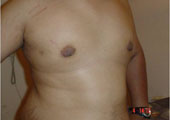| |

| Case
1 Before |
Case
1 After |
Case 2 Before |
Case 2 After |  |  |  |
|
| Gynaecomastia
( 'Male Breast Reduction' ) | | Gynaecomastia
may cause considerable psychological distress, especially in adolescents who are
struggling with issues related to sexual identity and self-image. Prolonged
presence of breast enlargement in the male patient leads to the development of
periductal fibrosis and stromal hyalinisation, preventing regression of breast
tissue and causing pain and discomfort due to the distension and tightness from
the hypertrophied breast. Since the surgery is straightforward, it offers a quick
remedy to the discomfort, physical and social, that the patient suffers. |
| The
operation | | This
is done through a small, semi-circular incision in the lower circumference of
the nipple, at its junction with the normal colored skin. A surprisingly large
gynaecomastia can be corrected through this innocuous incision. The surgery takes
about an hour and a half to do. Drains are inserted under the skin at the end
of the procedure. |
| Anaesthesia |
| I
prefer General Anaesthesia as it allows for better control over the patients vital
parameters. |
| Hospital
stay | | Patient
stays in hospital until the drains are removed, generally 48 to 72 hrs. |
| |
| Risks |
| Asymmetry
in size and shape is a possibility, though every effort is made to avoid this.
Lumpiness, more palpable than visible, cannot always be avoided, though this is
generally temporary. If the patient is relatively hairless, the scar may be visible.
In large gynaecomastia, the skin excess may take months to resolve, remaining
sometimes as a loose skin fold that may need additional correction at a later
date. | | |
| Post-operative
care | | After
drain removal, the patient is allowed to shower daily. Follow up is once in 3
to 4 days. Stitches are removed after 10-12 days. In very large gynaecomastia,
the patient may be asked to wear a chest corset to help the skin excess settle
faster and better. | | |
| What
to expect | | It
is very important for the patient to understand that every normal male also has
a breast mound. It is dangerous to surgically flatten the chest completely, since
this would endanger the blood supply to the skin, not to mention that the final
appearance may be abnormal. | | |
| Outcome |
| Although
the operation only reduces glandular and/or fat accumulation on the chest and
cannot replace dieting or exercise for weight loss, having the surgery can remove
any inhibitions that the patient may have in going to the gym or the swimming
pool. | | | | |
| | |
| | |




